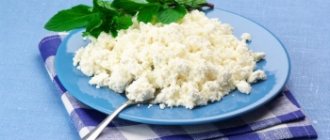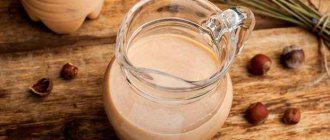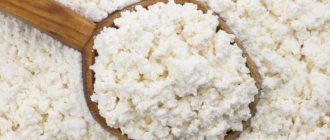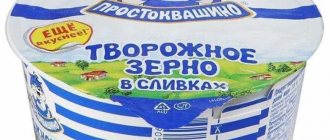Among the presented assortment of granular (granular) cottage cheese and curd masses in stores, you can find 4 main categories of this fermented milk product:
- Fat cottage cheese (fat percentage 19%, 20%, 23%).
- Classic cottage cheese (fat percentage 4 – 18%).
- Low-fat cottage cheese (fat percentage 2 - 3.8%).
- Low-fat cottage cheese (fat percentage 0 - 1.8%).
Consequently, the higher the fat content of the cottage cheese, the higher its calorie content. The calorie content of the most popular cottage cheeses (per 100 grams of product) is as follows:
- Calorie content of 9% cottage cheese is 159 calories.
- Calorie content of 5% cottage cheese is 121 calories.
- Calorie content of 2% cottage cheese is 103 calories.
- Calorie content of 1% cottage cheese is 159 calories.
- Calorie content of 0% cottage cheese is 71 calories.
Important: people who are obese and watch their diet should pay special attention to fatty cottage cheese, since it is higher in calories and is more difficult to digest in the human body.
The benefits of cottage cheese for the human body
- Cottage cheese is widely used in diets in the treatment of liver and heart diseases, hypertension and atherosclerosis.
- The beneficial amino acids that make up natural cottage cheese have a beneficial effect on the human circulatory system (in particular on the quality and production of the blood itself).
- Cottage cheese helps remove harmful substances from the human body.
- The benefits of cottage cheese for men are expressed in its beneficial effect on the reproductive system and potency, on the formation and strengthening of muscle and bone tissue, and strengthening the nervous system.
- The high calcium content in cottage cheese makes it one of the best foods for healthy teeth and bone tissue in the human body.
- Cottage cheese is useful for people who have allergies, as it helps reduce allergic reactions in the body and strengthen weakened immunity.
- The benefits of cottage cheese for women are expressed in strengthening hair and nails, the entire immune system of the female body, and it is also useful during pregnancy due to its high calcium content, which is so necessary during this period for the expectant mother and the development of a healthy fetus.
- The high protein content in cottage cheese is useful for people involved in sports, while curd protein is easily absorbed by the body.
- The benefits of cottage cheese for children have been known for a long time. This fermented milk product helps a young body grow, participates in the formation of strong bones and teeth, and is also useful for the development of muscle mass.
- Cottage cheese is also useful for older people, as it helps strengthen bone tissue, which is very important at this age.
Which cottage cheese is healthier, low-fat or full-fat?
Almost any cottage cheese is equally useful, but according to some scientists, when consuming low-fat cottage cheese, the calcium it contains is absorbed worse by the human body. Also, low-fat cottage cheese has a lower concentration of some vitamins and microelements.
The most useful cottage cheese is cottage cheese of medium fat content, since it has a balanced content of many useful substances and during production it is less processed (reduced or increased fat content). Also a good and healthy option is homemade granular cottage cheese, made naturally without special treatments.
How and at what time of day is it better to consume cottage cheese?
It is most beneficial to eat cottage cheese fresh, or in combination with honey, nuts and dried fruits, or simply with fruits or even herbs, as they contain a high content of other vitamins and microelements. Without additional heat treatment, the cottage cheese retains all its beneficial components. Quite often, cottage cheese is used in cooking; everyone loves and knows how delicious dumplings with cottage cheese, casseroles, cheesecakes, and cheesecakes are.
The human body accepts cottage cheese well when taken throughout the day, but when choosing the best time to eat cottage cheese, it is best to choose the morning time before 11:00 (as a second breakfast), or the time after lunch 16:00-17:00. It is better not to eat cottage cheese at night before going to bed, as it will take a long time to digest, which is not particularly beneficial for the body of a healthy person.
Harm of cottage cheese to the body
When eating cottage cheese, you always need to know when to stop, because if you constantly consume it in large quantities, it can harm our body. Possible harmful consequences of consuming cottage cheese and curd masses may include:
- Excessive consumption of fatty cottage cheese can significantly increase cholesterol levels in the body.
- Frequent consumption of cottage cheese in large quantities can lead to kidney problems due to the high protein content in this product.
- Cottage cheese is a perishable product, so it is always important to monitor its expiration date to avoid poisoning.
Important: nutritionists recommend not eating more than 100 grams of cottage cheese at a time and more than 3 times a week (the daily intake of cottage cheese for children is 50-60 grams). Even when playing sports and heavy physical activity, you need to know when to eat natural cottage cheese in moderation; you can eat it every day, but in small portions.
You will also be interested in articles about cottage cheese on the following topics:
In conclusion to the article, it can be noted that the benefits and harms of cottage cheese lie primarily in its unique composition, moreover, it is still one of the most useful fermented milk products, the main thing is to know when to use it in moderation. We leave our reviews about the benefits of cottage cheese for human health in the comments to the article and share it on social networks if it was useful to you.
How to distinguish cottage cheese from a curd product on the counter
According to the requirements of Rospotrebnadzor, manufacturers must indicate on the packaging what is contained inside: cottage cheese or a curd product. All names like “curd” and “curd mass” mean that this is not real cottage cheese, but a product produced on its basis. This significantly changes the shelf life of the product. This is the first thing buyers should pay attention to.
Cottage cheese
Cottage cheese is one of the most famous and healthy fermented milk products. In addition to the taste qualities for which it is famous, cottage cheese has many healing properties for the body.
According to historical evidence, cottage cheese was known in Ancient Rome. In Rus', it was traditionally obtained from yogurt - ordinary sour milk, which was placed in a heated oven in a clay pot, after which the curdled yogurt was poured into a linen bag so that the resulting whey was glassed. After this, the cottage cheese was placed under a press so that the whey was completely separated and a fairly dense mass was formed. Cottage cheese is still prepared in this way at home today.
Based on fat content, cottage cheese is usually divided into:
- Fat (18% or more);
- Bold (diet soft, 9%);
- Low-fat (up to 3%).
Cottage cheese is also distinguished by the method of coagulating milk proteins. It happens:
- Acidic, usually made from skim milk. In this case, the protein coagulates under the influence of lactic acid, which is formed during lactic acid fermentation;
- Acid-rennet, prepared with the simultaneous use of lactic acid bacteria starter and rennet enzyme.
Benefits and harms of cottage cheese 0 percent
It should be understood that cottage cheese with a 0 percent fat content does not exist. This figure is a publicity stunt. In reality, a product whose label says “0%” has a fat content of 0.1 to 1.8 percent. Low-fat cottage cheese has a low calorie content, so it is often used in dietetics. However, this product contains significantly less calcium and phosphorus than fattier varieties.
Regular consumption of low-fat cottage cheese has the following effects on health:
- promotes weight loss;
- strengthens the immune system;
- reduces the level of bad cholesterol in the blood;
- improves the health of teeth, nails and hair;
- supports the proper functioning of the digestive system;
- speeds up metabolism;
- prevents the development of anemia;
- strengthens the walls of blood vessels;
- helps with depression and insomnia;
- improves vision.
Read: The health benefits and harms of chicory
Despite its beneficial properties, this product will not benefit everyone. It is prohibited to eat it if you have the following health problems:
- kidney diseases;
- milk protein intolerance;
- gallstones or bladder stones.
Composition of cottage cheese
The nutritional value of cottage cheese is higher than milk, since usually about 200 g of cottage cheese can be prepared from 500 g of milk. In addition, the nutritional value of cottage cheese depends on its fat content. So, it contains:
- Fat – 15 g protein, 18 g fat, 2.8 g carbohydrates;
- Bold – 18 g protein, 9 g fat, 3 g carbohydrates;
- Low-fat - 22 g protein, 0.6 g fat, 3.3 g carbohydrates.
The composition of cottage cheese includes:
- Vitamins – A, D, C and B vitamins;
- Minerals – iron, calcium, phosphorus;
- Lactose (milk sugar);
- Enzymes.
Application
It is used not only in medicine. This miracle product has been known to the Slavic peoples for a very long time. Even our grandfathers and great-grandfathers created a tasty and healthy product from milk, which was soon used in all possible variations. These are delicious salty snacks or sweet aromatic pastries made from cottage cheese, which were made earlier and are not forgotten now, for example, many people still prepare Easter cake to this day. This is an important attribute of church celebrations and rituals.
The famous dumplings with cheese, cheesecakes with various fillings, pancakes with cottage cheese - these are masterpieces of Slavic cuisine. In modern times, this product is successfully used both in the art of confectionery and to enrich the body with useful substances during a diet.
Market Analytics
- COVID-19 is changing the rules of the game in the cosmetics market
- Beauty of the future: cosmetic innovations 2020
- New ingredients are the driving force of the cosmetics industry
Convenient search for beauty salons on our website
Beauty salons in Moscow Beauty salons in St. Petersburg Beauty salons in Ekaterinburg Beauty salons in Novosibirsk
Latest blog posts on our website
- Naturecream / Geranium (Pelargonium) oil for skin health and beauty
- Prostye-sovety / Save on a beauty salon: procedures that can be done at home
- Naturecream / Growth Factor - brings back youth?
- Oksana-Lezina / 3 effective abdominal exercises from a fitness instructor for beginners
- Prostye-sovety / Making perfect curls at home
- Prostye-sovety / Which hair removal method to choose
- Naturecream / Wrinkles Puppets
- Naturecream / PEPHA-TIGHT - instant skin lifting
- Naturecream / Blue light - a danger to the skin
- Naturecream / Cocoa Butter – A treat for the skin
Latest forum topics on our website
- Mrs._Smith / Badly sunburned! What to do?((
- Ice / Is it necessary to combine fitness classes with a diet?
- Antonova / What can be used for hair loss?
- Radio operatorKat / Who was on a protein diet?
- Suzanna / Mesotherapy on the face
Other articles in this section
| Nut milk Nut milk is a healthy, vitamin drink made from water and one or another type of nut. Most often, nut milk is made from almonds, but other nuts are also used. It tastes a little like soy milk. |
| Latvian cheese Latvian cheese, by its very name, indicates its belonging to a country such as Latvia, of which it is the national product. This cheese is quite popular and loved all over the world. Latvian cheese has numerous titles and awards; it is classified as a semi-hard rennet cheese. |
| Goat cheese Goat cheese is a high-calorie healthy product. The cheese is made from goat's milk. The technology involves curdling milk and keeping it at a certain temperature and humidity. Goat cheese has a delicate texture that melts in your mouth and a rich aroma. |
| Chechil Chechil Chechil cheese is not like other cheeses, it is made from bundles of fibrous threads, popularly called a pigtail. This cheese is a product of Armenia, very often it is sold smoked. This cheese in the Caucasus is made exclusively by hand: the threads are pulled out until they become as thin as hair. |
| Milk 1% Many peoples in the world create legends about such a drink as milk. In ancient Rome, residents believed that Jupiter himself was fed with milk. For its nutrition they used goat milk - Amalthea. That is why people brought milk to him as a sacrifice. Residents of Olympus also often drink milk. |
| Sour cream 20% (medium fat content) Sour cream is one of the most popular dairy products today. This product was actively consumed by our ancestors, but modern production technologies make it possible to make it not only tasty, but also very healthy. |
| Gouda cheese Gouda cheese is one of the most popular types of cheese. This is a hard cheese made from whole cow's milk. This type of cheese appeared a long time ago, back in the 12th century, its homeland is a small town in South Holland with the same name Gouda. There they first learned to make this type of cheese, and the city of Gouda is still a major cheese-making center in Holland. Gouda cheese has a fairly high fat content - about 48-51%. The raw material for making cheese is high-quality whole milk. |
| Rougette cheese Rougette cheese is a cheese with an attractive and refined taste. Bavaria is considered the birthplace of this cheese. The basis of the product is cow's milk and cream. Its distinctive feature is the paprika-based crust, which turns red. And the characteristic ammonia taste, washing the cheese rind five times and an equally noticeable piquant smell distinguishes it from other soft varieties. |
| Curdled milk 2.5% The unique and beneficial properties of this lactic acid product have been known for quite some time. Homer also mentions it in his work “Odyssey”. Nowadays, yogurt is popular because of its affordable price, and also because it can be prepared at home without any problems. To do this, you only need milk, sourdough (for example, regular bread) and sugar. |
| Nocerino cheese Nocerino cheese originates in Italy. It was there that they began to use the milk of certain breeds of sheep from the south of Italy using specially developed technologies to prepare this tasty and healthy cheese. To properly ripen Nocerino cheese, it is kept in a humid environment for two months, then wrapped in hazel leaves and aged for an additional 25 days. After this, its crust is treated with flax oil and again covered with walnut leaves. Thus, this type of cheese acquires its unique taste. It is classified as an exotic variety. |










